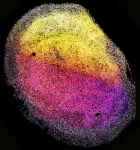(Press-News.org) ITHACA, N.Y. – Whirligig beetles, the world’s fastest-swimming insect, achieve surprising speeds by employing a strategy shared by speedy marine mammals and waterfowl, according to a new Cornell University study that rewrites previous explanations of the physics involved.
The centimeter-long beetles can reach a peak acceleration of 100 meters per second and a top velocity of 100 body lengths per second (or one meter per second).
Not only do the results explain the whirligig’s Olympian speeds, but they also offer valuable insights for bio-inspired designers of near-surface water robots and uncrewed boats.
Until now, researchers have believed that whirligigs attain their impressive speeds using a propulsion system called drag-based thrust. This type of thrust requires the insect’s legs to move faster than the swimming speed, in order for the legs to generate any thrust. For the whirligig beetle to achieve such fast swimming speeds, its legs would need to push against the water at unrealistic speeds.
“It could have well been questioned,” said Chris Roh, assistant professor of biological and environmental engineering. “The fastest swimmer and drag-based thrust don’t usually go together in the same sentence.”
In fact, fast-swimming marine mammals and waterfowls tend to forgo drag-based thrust in favor of lift-based thrust, another propulsion system. The finding was described in a study published Jan. 8 in the journal Current Biology.
Using two high-speed cameras synchronized at different angles, the researchers were able to film a whirligig and observe a lift-based thrust mechanism at play. Lift-based thrust works like a propeller, where the thrusting motion is perpendicular to the water surface, eliminating drag and allowing for more efficient momentum capable of greater speed.
Lift-based thrust has previously been identified in large-scale organisms, such as whales, dolphins and sea lions. “In this work, we extended the length-scale down to one centimeter, which means that whirligig beetles are by far the smallest organism to use lift-based thrust for swimming,” said Yukun Sun, a doctoral student in Roh’s lab and the paper’s first author.
“We’re hoping that this speaks to bio-inspired robotics and other engineering communities to first identify the right physics and then try to preserve that physics in creating the robotics,” Roh said.
The U.S. Navy has been developing uncrewed boats, as traditional ship design is constrained by the need to make boats hospitable to a crew. By eliminating a crew, boats can be much smaller and more flexible. Roh believes that the small size, ship-like shape and lift-generating propulsion mechanism of whirligigs translate well to inform robotic ship designs.
The study was funded by the National Science Foundation.
For additional information, see this Cornell Chronicle story.
Media note: Video of the whirligig beetle can be viewed and downloaded here: https://cornell.box.com/v/whirligigbeetles
-30-
END
Fastest swimming insect could inspire uncrewed boat designs
2024-01-08
ELSE PRESS RELEASES FROM THIS DATE:
Why do we sleep? Researchers propose an answer to this age-old question
2024-01-08
Sleep is a fundamental need, just like food or water. “You’ll die without it,” said Keith Hengen, an assistant professor of biology at Washington University in St. Louis. But what does sleep actually accomplish? For years, the best researchers could say is that sleep reduces sleepiness — hardly a satisfying explanation for a basic requirement of life.
But by melding concepts from the fields of physics and biology, Hengen and a team of Arts & Sciences researchers have constructed a theory that could explain both the meaning of sleep and the complexity of the brain. As reported in a new study published ...
Singh studying distributed computing models and algorithms for pervasive systems
2024-01-08
Gurdip Singh, Divisional Dean, School of Computing, received funding from the National Science Foundation for the project: "EAGER: Distributed Computing Models and Algorithms for Pervasive Systems."
The goal of this project is to extend the traditional graph-based distributed computing models and algorithms to develop a unified model to study cyber-physical systems. The unified models will capture interactions between the physical and cyber entities and the physical phenomena. This project also proposes to develop techniques to design distributed algorithms for fundamental problems ...
Narayanan developing treatments for alphaviruses
2024-01-08
Aarthi Narayanan, Professor, Biology, received funding for the project: "Further the development of Omaveloxolone and Bardoxolone methyl as broadly effective countermeasures against alphaviruses to Support the Battelle Accelerated Therapeutics for Combating Acute Viral Epidemics (BAT-CAVE) Program."
The principal purpose of this program is to conduct Research and Development into medical, pharmaceutical, and diagnostic technologies to enhance mission effectiveness of military personnel, collaborating ...
SwRI awarded $54 million contract to develop QuickSounder weather satellite
2024-01-08
SAN ANTONIO — January 8, 2024 —NASA and NOAA have selected Southwest Research Institute (SwRI) to develop QuickSounder, the first in a new generation of NOAA low-Earth orbit environmental satellites. Under the $54 million contract, SwRI will design and build the satellite and operate it for three years.
QuickSounder will kick off NOAA’s Near Earth Orbit Network (NEON) program. The Near Earth Orbit Network is a collaborative mission between NASA and NOAA. NASA will manage the development and launch of the satellites for NOAA, which will operate them and deliver data to users worldwide. NEON satellites ...
Novel tissue-derived brain organoids could revolutionize brain research
2024-01-08
Press release – Princess Máxima Center for pediatric oncology
EMBARGO: 8 JANUARY 2024 AT 11:00 AM ET (US)
Scientists have developed 3D mini-organs from human fetal brain tissue that self-organize in vitro. These lab-grown organoids open up a brand-new way of studying how the brain develops. They also offer a valuable means to study the development and treatment of diseases related to brain development, including brain tumors.
Scientists use different ways to model the biology of healthy tissue and disease in the lab. These include cell lines, laboratory animals and, since a few years, 3D mini-organs. ...
SARS-CoV-2 BA.2.86 is less resistant to vaccine, but may be a problem in the lung
2024-01-08
COLUMBUS, Ohio – New research shows that the recently emerged BA.2.86 omicron subvariant of the virus that causes COVID-19 can be neutralized by bivalent mRNA vaccine-induced antibodies in the blood, which explains why this variant did not cause a widespread surge as previously feared.
However, the study in cell cultures showed this SARS-CoV-2 variant can infect human cells that line the lower lung and engage in virus-host cell membrane fusion more efficiently, two features linked to severe disease symptoms.
The study is published today (Jan. 8, 2024) in the journal Cell.
The BA.2.86 variant of omicron is the ancestor of the currently dominating JN.1 and has about ...
Sibling death in childhood and early adulthood and risk of early-onset cardiovascular disease
2024-01-08
About The Study: In this study of more than 2 million individuals born in Denmark, sibling death in childhood and early adulthood was associated with increased risks of overall and most type-specific early-onset cardiovascular diseases, with the strength of associations varying by cause of death and age difference between sibling pairs. The findings highlight the need for extra attention and support to the bereaved siblings to reduce cardiovascular disease risk later in life.
Authors: Guoyou Qin, Ph.D., and Yongfu Yu, Ph.D., ...
Early-life digital media experiences and development of atypical sensory processing
2024-01-08
About The Study: Early-life digital media exposure was associated with atypical sensory processing outcomes in multiple domains in this study that included 1,471 children. These findings suggest that digital media exposure might be a potential risk factor for the development of atypical sensory profiles. Further research is needed to understand the relationship between screen time and specific sensory-related developmental and behavioral outcomes, and whether minimizing early-life exposure can improve subsequent sensory-related outcomes.
Authors: Karen F. Heffler, M.D., of the Drexel University ...
Diagnostic errors in hospitalized adults who died or were transferred to intensive care
2024-01-08
About The Study: Diagnostic errors in hospitalized adults who died or were transferred to the intensive care unit were common and associated with patient harm in this analysis of 2,428 patient records at 29 hospitals. Problems with choosing and interpreting tests and the processes involved with clinician assessment are high-priority areas for improvement efforts.
Authors: Andrew D. Auerbach, M.D., M.P.H., of the University of California, San Francisco, is the corresponding author.
To access the embargoed study: Visit ...
Putting your toddler in front of the TV? You might hurt their ability to process the world around them, new data suggests
2024-01-08
Babies and toddlers exposed to television or video viewing may be more likely to exhibit atypical sensory behaviors, such as being disengaged and disinterested in activities, seeking more intense stimulation in an environment, or being overwhelmed by sensations like loud sounds or bright lights, according to data from researchers at Drexel’s College of Medicine published today in the journal JAMA Pediatrics.
According to the researchers, children exposed to greater TV viewing by their second birthday were more likely to develop atypical sensory processing behaviors, such as “sensation seeking” and “sensation ...

